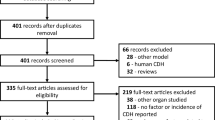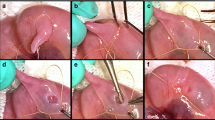Summary
The purpose of this study was to determine whether hypoplasia of the lung bud might be responsible for cases of congenital diaphragmatic hernia (CDH). The lung bud normally develops in close association with the posthepatic mesenchymal plate (PHMP). The PHMP appears dorsal to the liver or on the ventral aspect of the pleuroperitoneal canal when the lung bud enters the pleuroperitoneal canal. Later, the PHMP grows to join the costal mesenchymal tissue via the pleuroperitoneal fold, thereby forming the primitive diaphragm. The present study found that the PHMP plays a cardinal role in the development of the diaphragm and that hypoplasia of the lung bud preceded hypoplasia of the PHMP in mice with CDH produced by the administration of Nitrofen to their pregnant nothers. This, along with findings related to the development of the phrenic nerve, makes it possible that pulmonary aypoplasia is a causal factor in the origin of congenital diaphragmatic hernia.
Similar content being viewed by others
References
Ambrose AM, Larson PS, Bozelleca JF, Smith JF, Henningar GR (1971) Toxicologic studies on 2,4-dichlorophenyl-p-nitrophenyl ether. Toxicol Appl Pharmacol 19:263–275
Costlow RD, Manson JM (1981) The heart and diaphragm: Target organs in the neonatal death induced by Nitrofen (2,4-dichlorophenyl-p-nitrophenyl ether). Toxicology 20:209–227
Delorimier AA, Tierney DF, Parker (1967) Hypoplastic lungs in fetal lambs surgically produced congenital diaphragmatic hernia. Surgery 62:12–17
Ehrlich FE, Salzberg AM (1978) Pathophysiology and management of congenital posterolateral diaphragmatic hernias. Am Surg 75:26–30
Gray LE, Kavlock RJ, Chernoff N, Ferrell J, Mclamb J, Ostby J (1982) Prenatal exposure of the herbicide 2,4-dichlorophenyl-p-nitrophenyl ether destroys the Rodent Harderian gland. Science 215:293–294
Harrison MR, Jester JA, Ross NA (1980) Correction of congenital diaphragmatic hernia in utero. I. The model: intrathoracic balloon produces fetal pulmonary hypoplasia. Surgery 88:174–182
Haworth SG, Reid L (1976) Persistent fetal circulation: Newly recognized structural feature. J Pediatr 88:614–620
Hislop A, Reid L (1976) Persistent hypoplasia of the lung after repair of congenital diaphragmatic hernia. Thorax 31:450–454
Kimbrough RD, Gaines TB, Linder RE (1974) 2,4-dichlorophenyl-p-nitrophenyl ether (TOK), Effects on the lung maturation of rat fetus. Arch Environ Health 28:316–320
Levin DL (1978) Morphologic analysis of the pulmonary vascular bed in congenital left sided diaphragmatic hernia. J Pediatr Surg 13:805–809
Levin DL (1979) Primary pulmonary hypoplasia. J Pediatr 95:550–551
Moore KL (1977) Development of the diaphragm. In: The developing human. Second ed, Saunders Philadelphia
Müntener M (1968) Beitrag zur Kenntnis der Entwicklung des menschlichen Zwerchfells. Z Kinderchir 5:350–366
Nakao Y, Iritani I, Kishimoto H (1981) Experimental animal model of congenital diaphragmatic hernia induced chemically. Teratology 24:11A
Reale FR, Esterly JR (1973) Pulmonary hypoplasia: A morphometric study of the lung of infants with diaphragmatic hernia, anencephaly, and renal malformation. Pediatrics 51:91–96
Stone LC, Manson JM (1981) Effects of the herbicide 2,4-dichlorophenyl-p-nitrophenyl ether (Nitrofen) on fetal lung development in rats. Toxicology 20:195–207
Sullivan H (1956) Supernumerary diaphragm with agenesis of upper lobe. J Thorac Surg 34:544–547
Tada T, Iritani I, Kishimoto H (1981) Pathological study of ductus arteriosus. I. (in Japanese) Tr Soc Pathol Jpn 70:194
Thomas MH, Keith WA (1979) Congenital diaphragmatic hernia. In: Ravitch MR, Welch KJ, Benson CD, Aberdeen E, Randolph JG (eds) Pediatric Surgery. third ed, Vol 1 Year Book Medical Publishers, Inc. Chicago-London
WellsLJ (1954) Development of the human diaphragm and pleural sacs Contr Embryol Carneg Instn 35:107–134
Wohl MFB, Griscom NT, Strieder DJ, Treves S, Zwerdling RG (1977) The lung following repair of congenital diaphragmatic hernia. J Pediatr 90:405–414
Author information
Authors and Affiliations
Rights and permissions
About this article
Cite this article
Iritani, I. Experimental study on embryogenesis of congenital diaphragmatic hernia. Anat Embryol 169, 133–139 (1984). https://doi.org/10.1007/BF00303142
Accepted:
Issue Date:
DOI: https://doi.org/10.1007/BF00303142




